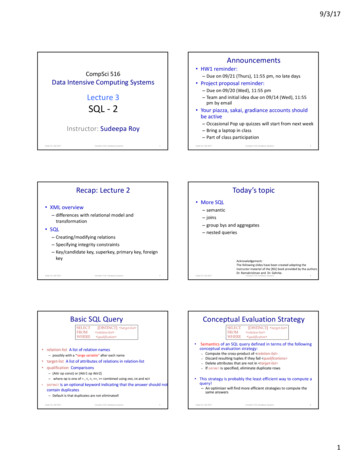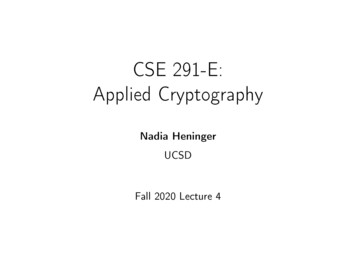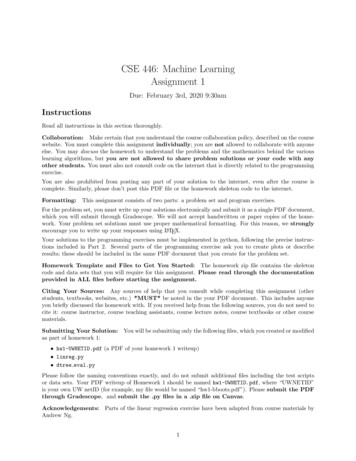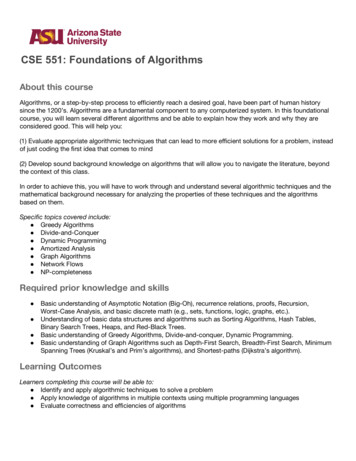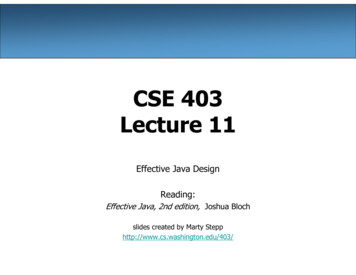
Transcription
CSE 403Lecture 11Effective Java DesignReading:Effective Java, 2nd edition, Joshua Blochslides created by Marty Stepphttp://www.cs.washington.edu/403/
Levels of access private: visible only to one class package-private (default): visible to current package protected: visible to current packages, and any subclasses public: visible to any other class– Which level of access is best for fields?For methods? Constructors? For classes?2
Effective Java Item 13 Item 13: Minimize the accessibility of classes and members. Item 14: In public classes, use accessor methods, not public fields.– Should fields always be private?– Should methods always be public?– Why might it be useful to have a non-public class?– Poker question: The poker Player class wants to share its internaldata "setter" methods with some classes, such as the PokerGame.But it doesn't want some other classes, such as rival players, tobe able to set arbitrary data. How can this be achieved?3
Packages package: a group of related Java classes––––more useful in larger projectshelps group related classes and functionality into subsystemscreates a new separate namespaceprovides a layer of access control (can set a class or member as private to a package)– In Java, packages mirror folders package foo.bar should be stored infolderfoo/bar/4
Classpath class path: The location(s) in which Java looks for class files. Can include:–––––the current "working directory" from which you ran javac / javaother foldersJAR archivesURLs. Can set class path manually running Java at command line:– java -cp /home/stepp/libs:/foo/bar/jbl MyClass5
A package declarationpackage name;public class name { .Example:package pacman.model;public class Ghost extends Sprite {.} File Sprite.java should go in folder pacman/model .6
Importing a packageimport packageName.*;// all classesExample:package pacman.gui;import pacman.model.*;public class PacManGui {.Ghost blinky new Ghost();} PacManGui must import the model package to use it.7
Packages in UML UML class diagrams can depict packages as "folders":8
Packages in Practice-It total lines of code:– practiceit (4302) / data (277), junit (692); util (2905) / io (289);sandbox (6688) total 151539
Poker design question The game has different kinds of players, including human,computer and network.How should these types of players be represented in the code?– As a play() method in the PokerGame class with lots of if/elses.– A Player class with a type field such as HUMAN, COMPUTER, etc.– A Player class with subclasses like HumanPlayer, etc.– A Player interface implemented by classes HumanPlayer, etc.10
Interfaces interfaces should be used when you want:– polymorphism: treat different types of objects the same way– examples: List -- ArrayList, LinkedList Map-- HashMap, TreeMap Iterator Comparable ActionListener– Java interfaces are sometimes also used for "tagging" abilities Cloneable; Serializable; Iterable11
Inheritance inheritance should be used when you want:– polymorphism: treat different types of objects the same way– code sharing: subclass receives code from superclass– substitutability: client code can use a subclassobject in any situation where a superclass objectwas expected, and expect the same results ("Liskov Substitutability Principle")– example: Java Swing GUI framework JComponent class properties: size, location, color, font, text label, border, events . extended by JButton, JTextField, JCheckBox, JSlider, etc. any JComponent may be substituted for another in many cases12
Effective Java Items 16-20 Item 16: Favor composition over inheritance.– has-a can be better than is-a– "Lots of people HAVE a lawyer, but ." Item 18: Prefer interfaces to abstract classes.– compromise: use both (java.util.List and AbstractList) Item 20: Prefer class hierarchies to "tagged" classes.– if you have a type or kind field, it's probably bad13
Java Swing GUI hierarchy14
Case Study: SortedIntList In CSE 143, I assign a program SortedIntList.– SortedIntList extends a provided ArrayIntList : public public public public public public public public public public publicvoid add(int value)void add(int index, int value)void clear()boolean contains(int value)int get(int index)int indexOf(int value)boolean isEmpty()void remove(int index)void set(int index, int value)int size()String toString()– Is this a good design? Why or why not?15
Poker design question When a player makes a bet, a Bet object is produced.– Other Players need to know about the bet so they can decide howto respond to it (raise, fold, etc.).– But if we pass the Bet object to them, they could be evil andchange it by calling methods like setAmount, cancel, etc.– How do we make it possible to inform the players about the Betwithout its object being damaged?16
Mutation mutation: A modification to the state of an object.Point p new Point(3, 5);System.out.println(p);// (3, 5)p.translate(1, 3);// mutatorSystem.out.println(p);// (4, 8) Mutation must be done with care.– Can the object's state be damaged?– Is the old state important? Is it okay to "lose" it?– Do any other clients depend on this object? Do they expect that its state will not change?17
Effective Java item 15 Item 15: Minimize mutability.– immutable: Unable to be changed. achieved in Java by omitting set methods and/or using final fieldspublic class Bet {private final int amount;public Bet(int amount) {this.amount amount;}public int getAmount() { return amount; }.}– If the Bet's amount field cannot be changed, what if the playerwants to use a different bet amount later?18
Defensive copying defensive copy: To duplicate an object prior to a mutation.Point p new Point(3, 5);System.out.println(p);Point copy p.clone();copy.translate(1, // (3, 5)// mutator// (4, 8)// (3, 5)– Sometimes you then perform the mutation to the copy.– Sometimes you perform the mutation to the original object. The copy serves as a "backup" in case the mutation is undesirable.– EJ Tip #39: Make defensive copies when needed.19
A poor design Suppose we have a BankAccount class:– getBalance method returns the bank account's balance.– The method also charges a 1.50 fee if you ask for the balancetoo many times (calling the method more than 3x per day). Why is this a poor design?– Don't combine a crucial accessor with an unrelated mutation. Impossible to access without (unintentionally?) mutating.– Client might call it without thinking, to print balance etc. Another client might have already called the method before me.– side effects: Additional externally visible behavior beyond thecore functionality of a method.20
Minimizing mutability Effective Java Tip #15: Minimize mutability. Why?–––––easier to design, implement, and use immutable objectsless prone to developer errorless prone to misuse by clientsmore securecan be optimized for better performance / memory use(sometimes)– from Effective Java: "Classes should be immutable unless there isa very good reason to make them mutable." "If a class cannot be immutable, limit its mutability as much aspossible."21
Making a class immutable 1. Don't provide any methods that modify the object's state. 2. Ensure that the class cannot be extended. 3. Make all fields final. 4. Make all fields private. (ensure encapsulation) 5. Ensure exclusive access to any mutable object fields.– Don't let a client get a reference to a field that is a mutableobject.(Don't allow any mutable representation exposure.)22
The final keyword final: Unchangeable; unable to be redefined or overridden. Can be used with:– local variables (value can be set once, and can never bechanged)– fields– static fields (they become "class constants")– classes (the class becomes unable to be subclassed)– methods (the method becomes unable to be overridden) Effective Java Tip #17: Design and document forinheritance or else prohibit it (by making your class final).23
Examples of final on a local variable:final int answer 42; on a field:private final String name;– set in constructor on a static constant:public static final int DAYS 7; on a class:public final class Point {– no class can extend Point on a method:public final int getX()– no class can override getX (not necessary if class is alreadyfinal)24
Mutable Fraction classpublic class Fraction implements Cloneable, Comparable Fraction {private int numerator, denominator;publicpublicpublicpublicFraction(int n)Fraction(int n, int d)int getNumerator(), getDenominator()void setNumerator(int n), setDenominator(int d)publicpublicpublicpublicFraction clone()int compareTo(Fraction other)boolean equals(Object o)String add(Fraction other)subtract(Fraction other)multiply(Fraction other)divide(Fraction other)}– How would we make this class immutable?25
Immutable Fraction classpublic final class Fraction implements Comparable Fraction {private final int numerator, denominator;public Fraction(int n)public Fraction(int n, int d)public int getNumerator(), getDenominator()// no more setN/D methods// no clone method neededpublic int compareTo(Fraction other)public boolean equals(Object o)public String FractionFractionadd(Fraction other)subtract(Fraction other)multiply(Fraction other)divide(Fraction other)////////past mutatorsare producers(return a new(object)}26
Other design principles The Open/Closed Principle: Software entities (classes, modules, etc) should be open forextension, but closed for modification. The Liskov Substitution Principle: Derived classes must be usable through the baseclass interface without the need for the user to know the difference. The Dependency Inversion Principle: Details should depend upon abstractions.Abstractions should not depend upon details. The Interface Segregation Principle: Many client-specific interfaces are better than onegeneral purpose interface. The Reuse/Release Equivalency Principle: The granule of reuse is the same as thatrelease. Only components released through a tracking system can be effectively reused. The Common Closure Principle: Classes that change together, belong together. The Common Reuse Principle: Classes that aren't reused together shouldn't be grouped. The Acyclic Dependencies Principle: The dependency structure for released componentsmust be a directed acyclic graph. There can be no cycles. The Stable Dependencies Principle: Dependencies between released categories mustrun in the direction of stability. The dependee must be more stable than the depender. The Stable Abstractions Principle: The more stable a class category is, the more it mustconsist of abstract classes. A completely stable category is nothing but abstract classes.27
Effective Java Item 13 Item 13 : Minimize the accessibility of classes and members. Item 14 : In public classes, use accessor methods, not public fields. –Should fields always be private? –Should methods always be public? –Why might it be useful to have a non-public class?
